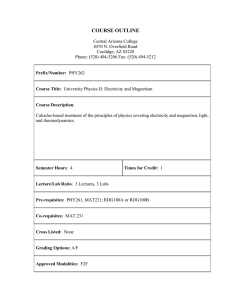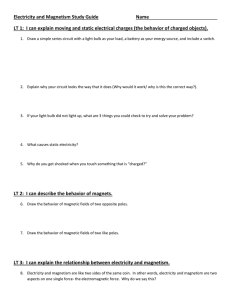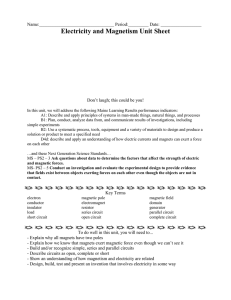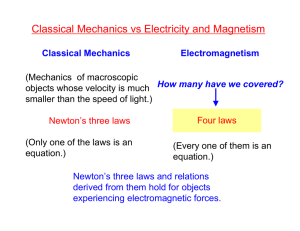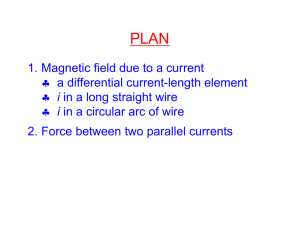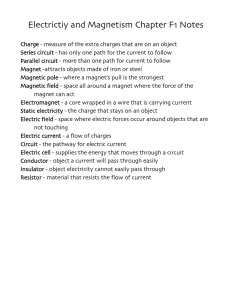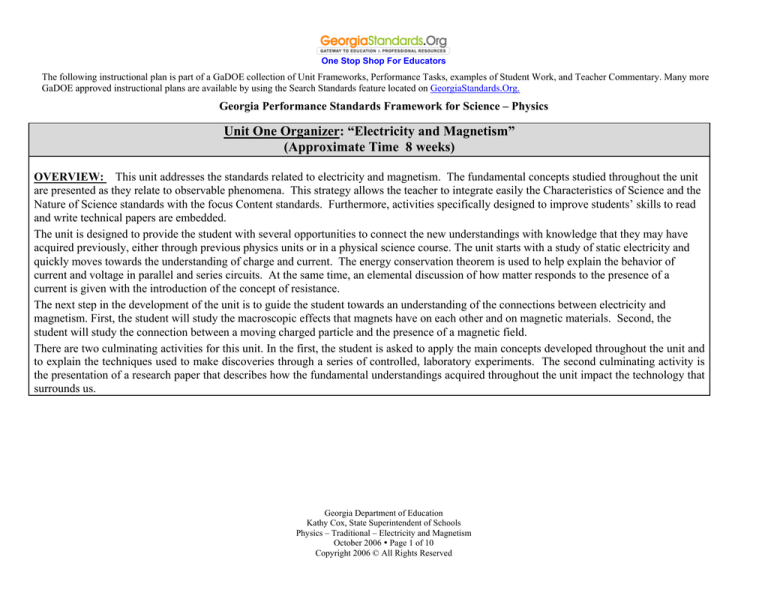
One Stop Shop For Educators
The following instructional plan is part of a GaDOE collection of Unit Frameworks, Performance Tasks, examples of Student Work, and Teacher Commentary. Many more
GaDOE approved instructional plans are available by using the Search Standards feature located on GeorgiaStandards.Org.
Georgia Performance Standards Framework for Science – Physics
Unit One Organizer: “Electricity and Magnetism”
(Approximate Time 8 weeks)
OVERVIEW: This unit addresses the standards related to electricity and magnetism. The fundamental concepts studied throughout the unit
are presented as they relate to observable phenomena. This strategy allows the teacher to integrate easily the Characteristics of Science and the
Nature of Science standards with the focus Content standards. Furthermore, activities specifically designed to improve students’ skills to read
and write technical papers are embedded.
The unit is designed to provide the student with several opportunities to connect the new understandings with knowledge that they may have
acquired previously, either through previous physics units or in a physical science course. The unit starts with a study of static electricity and
quickly moves towards the understanding of charge and current. The energy conservation theorem is used to help explain the behavior of
current and voltage in parallel and series circuits. At the same time, an elemental discussion of how matter responds to the presence of a
current is given with the introduction of the concept of resistance.
The next step in the development of the unit is to guide the student towards an understanding of the connections between electricity and
magnetism. First, the student will study the macroscopic effects that magnets have on each other and on magnetic materials. Second, the
student will study the connection between a moving charged particle and the presence of a magnetic field.
There are two culminating activities for this unit. In the first, the student is asked to apply the main concepts developed throughout the unit and
to explain the techniques used to make discoveries through a series of controlled, laboratory experiments. The second culminating activity is
the presentation of a research paper that describes how the fundamental understandings acquired throughout the unit impact the technology that
surrounds us.
Georgia Department of Education
Kathy Cox, State Superintendent of Schools
Physics – Traditional – Electricity and Magnetism
October 2006 y Page 1 of 10
Copyright 2006 © All Rights Reserved
One Stop Shop For Educators
Georgia Performance Standards Framework for Science – Physics
STANDARDS ADDRESSED IN THIS UNIT
Focus Standard:
SP5. Students will evaluate relationships between electrical and magnetic forces.
a. Describe the transformation of mechanical energy into electrical energy and the transmission of electrical energy.
b. Determine the relationship among potential difference, current, and resistance in a direct current circuit.
c. Determine equivalent resistances in series and parallel circuits.
d. Determine the relationship between moving electric charges and magnetic fields.
SP3. Students will evaluate the forms and transformations of energy.
g. Analyze and measure power.
Supporting content Standards
SP3. Students will evaluate the forms and transformations of energy
a. Analyze, evaluate, and apply the principle of conservation of energy and measure the components of work-energy theorem by
• describing total energy in a closed system.
• identifying different types of potential energy.
Characteristics of Science Standards
SCSh1. Students will evaluate the importance of curiosity, honesty, openness, and skepticism in science.
a. Exhibit the above traits in their own scientific activities.
b. Recognize that different explanations often can be given for the same evidence.
SCSh2. Students will use standard safety practices for all classroom laboratory and field investigations.
a. Follow correct procedures for use of scientific apparatus.
b. Demonstrate appropriate technique in all laboratory situations.
c. Follow correct protocol for identifying and reporting safety problems and violations.
Georgia Department of Education
Kathy Cox, State Superintendent of Schools
Physics – Traditional – Electricity and Magnetism
October 2006 y Page 2 of 10
Copyright 2006 © All Rights Reserved
One Stop Shop For Educators
Georgia Performance Standards Framework for Science – Physics
SCSh3. Students will identify and investigate problems scientifically.
a. Suggest reasonable hypotheses for identified problems.
b. Develop procedures for solving scientific problems.
c. Collect, organize and record appropriate data.
d. Graphically compare and analyze data points and/or summary statistics.
e. Develop reasonable conclusions based on data collected.
f. Evaluate whether conclusions are reasonable by reviewing the process and checking against other available information.
SCSh4. Students will use tools and instruments for observing, measuring, and manipulating scientific equipment and materials.
a. Develop and use systematic procedures for recording and organizing information.
b. Use technology to produce tables and graphs.
c. Use technology to develop, test, and revise experimental or mathematical models.
SCSh5. Students will demonstrate the computation and estimation skills necessary for analyzing data and developing reasonable
scientific explanations.
a. Trace the source on any large disparity between estimated and calculated answers to problems.
b. Consider possible effects of measurement errors on calculations.
c. Recognize the relationship between accuracy and precision.
d. Express appropriate numbers of significant figures for calculated data, using scientific notation where appropriate.
e. Solve scientific problems by substituting quantitative values, using dimensional analysis and/or simple algebraic formulas as appropriate.
SCSh6. Students will communicate scientific investigations and information clearly.
a. Write clear, coherent laboratory reports related to scientific investigations.
b. Write clear, coherent accounts of current scientific issues, including possible alternative interpretations of the data
c. Use data as evidence to support scientific arguments and claims in written or oral presentations.
d. Participate in group discussions of scientific investigation and current scientific issues.
Georgia Department of Education
Kathy Cox, State Superintendent of Schools
Physics – Traditional – Electricity and Magnetism
October 2006 y Page 3 of 10
Copyright 2006 © All Rights Reserved
One Stop Shop For Educators
Georgia Performance Standards Framework for Science – Physics
The Nature of Science Standards
SCSh7. Students will analyze how scientific knowledge is developed.
b. Universal principles are discovered through observation and experimental verification.
e. Testing, revising, and occasionally rejecting new and old theories never ends.
SCSh8. Students will understand important features of the process of scientific inquiry.
a. Scientific investigators control the conditions of their experiments in order to produce valuable data.
b. Scientific researchers are expected to critically assess the quality of data including possible sources of bias in their investigations,
hypotheses, observations, data analyses, and interpretations.
e. The ultimate goal of science is to develop an understanding of the natural universe which is free of biases.
Reading Standard
SCSh9. Students will enhance reading in all curriculum areas by:
a. Reading in all curriculum areas
• Read technical texts related to various subject areas.
c. Building vocabulary knowledge
• Demonstrate an understanding of contextual vocabulary in various subjects.
• Use content vocabulary in writing and speaking.
• Explore understanding of new words found in subject area texts.
d. Establishing context
• Explore life experiences related to subject area content.
• Determine strategies for finding content and contextual meaning for unknown words.
Georgia Department of Education
Kathy Cox, State Superintendent of Schools
Physics – Traditional – Electricity and Magnetism
October 2006 y Page 4 of 10
Copyright 2006 © All Rights Reserved
One Stop Shop For Educators
Georgia Performance Standards Framework for Science – Physics
ENDURING UNDERSTANDINGS
1.
The electric force exerted by a charged particle on another is proportional to the product of their charges and inversely proportional to the
square of the distance between them.
2. The higher the potential difference between two points in a circuit the greater the amount of current passing through it as long as the
resistance is kept constant.
3. Electric potential difference is the difference in electric potential between two different locations within an electric field.
4. In a parallel circuit, the voltage across the parallel elements is the same and the current passing through each one is inversely proportional
to the ratio of their resistances.
5. In a series circuit, the current passing through all the elements of the circuit is the same.
6. In a series circuit, the total resistance of the circuit is equal to the sum of the resistances of the individual elements of the circuit.
7. The sum of voltage dropped on a closed loop of a circuit is zero.
8. Magnetic fields are created by electric currents and can be macroscopic like the current through a wire or microscopic like the one created
by the moving of electrons in their atomic orbits.
9. A magnetic field affects the trajectory of a charged particle moving through it.
10. A variable magnetic field will induce an electric current and a variable current will induce a magnetic field.
11. Transformers are used to change the voltage in a circuit by stepping it up or down.
ESSENTIAL QUESTIONS:
1.
2.
3.
4.
5.
6.
Why does the presence of a magnet near a computer screen affect the image formed on the screen?
How does the electric energy generated in a power plant reach your home?
What conditions make it advantageous to connect lights on a parallel configuration instead of a series configuration?
How is energy stored in a battery?
Why do electrical engineers working with circuits in computers need to worry about the length of the paths that the current travels
between different electric components?
Why do some materials make good magnets and others do not?
Georgia Department of Education
Kathy Cox, State Superintendent of Schools
Physics – Traditional – Electricity and Magnetism
October 2006 y Page 5 of 10
Copyright 2006 © All Rights Reserved
One Stop Shop For Educators
Georgia Performance Standards Framework for Science – Physics
CONCEPTS:
Electrical potential energy, potential difference, current, resistance, parallel circuits, series circuits, magnetic field, magnetic force, electric
field, electric force, power, and electrons.
LANGUAGE:
Current, electricity, magnetism, resistance, voltage, potential difference, charge, electron, ion, transformer, resistor, circuit, parallel circuit,
series circuit, electric force, magnetic force, battery, energy, conductor, insulator, proton, Ohm’s law, power plant, static electricity, magnetic
field, voltmeter, ammeter, multimeter, Pythagorean theorem, significant figures, calculate, experiment, precision measure, accuracy, SI units,
describe, scientific notation, conclusion, hypothesis, data, contrast, compare, variable, infer, analyze, predict, interpret.
MISCONCEPTIONS AND PROPER CONCEPTIONS
MISCONCEPTIONS
An electromagnet must have an iron core.
Larger magnets are stronger than smaller ones.
Magnets can be used to separate metals from non-metals.
Batteries are a source of charge.
Electricity is a form of energy.
Current is a type of electrical energy.
PROPER CONCEPTIONS
An electromagnet is a wire coiled around a cylinder. It may or
may not have an iron core.
The strength of the magnetic force generated by a magnet depends
upon the number of turns, current, and core material.
Some metallic materials are not magnetic. Therefore, magnets
cannot always be used to separate metals from non-metals.
A battery creates a potential difference; it does not produce a
charge.
Electricity is the effect of the apparent motion by an electric
current.
Current is produced by the apparent motion of electrons along a
conductor.
Georgia Department of Education
Kathy Cox, State Superintendent of Schools
Physics – Traditional – Electricity and Magnetism
October 2006 y Page 6 of 10
Copyright 2006 © All Rights Reserved
One Stop Shop For Educators
Georgia Performance Standards Framework for Science – Physics
MISCONCEPTIONS AND PROPER CONCEPTIONS (continued)
MISCONCEPTIONS
Batteries are good conductors.
Electric current is a flow of negative charges.
Electric companies sell electricity.
Positively charged objects have extra protons.
A charged body has only one type of charge.
The electric force is the same as the gravitational force.
PROPER CONCEPTIONS
A battery does not conduct electrons; it creates a potential
difference.
Electric current is the flow of charged particles, which may be
negatively or positively charged.
Electric companies sell energy (kW hr is a unit of energy. This is
the unit on one’s electric bill).
Positively charged objects have lost electrons creating an ion with
a greater number of protons than electrons.
Charged objects have an excess of positive or negative charges.
All objects are made up of protons and electrons, but objects
which carry a net positive or negative charge have more or fewer
electrons than are balanced by the number of protons present.
The magnitude of the gravitational and electric forces is, in both
cases, inversely proportional to the square of the distances between
the masses (gravitational) or charges (electric). However,
gravitational forces are weaker than electric forces.
Georgia Department of Education
Kathy Cox, State Superintendent of Schools
Physics – Traditional – Electricity and Magnetism
October 2006 y Page 7 of 10
Copyright 2006 © All Rights Reserved
One Stop Shop For Educators
Georgia Performance Standards Framework for Science – Physics
EVIDENCE OF LEARNING:
By the conclusion of this unit, students should be able to demonstrate the following
competencies:
Culminating Activity:
This culminating activity requires the students to work in groups of three or four. Each
student is to complete his or her own laboratory report. To complete the activity the students
will rotate through four different laboratory stations. On each station the students must
complete the task, collecting the data and or making the necessary observations.
The student’s lab report must contain the following parts:
1. Cover Page
i. Student name
ii. Date of the laboratory
iii. Title of the laboratory
iv. Names of team members
2. Introduction
v. Theory behind the experiment
vi. Purpose or Objective
vii. Hypothesis
3. Materials
4. Procedure
5. Data Collection
i. Tables
ii. Written observations
6. Data Calculations
i. Examples of calculations need to be present.
ii. Graphs (Student should use graph paper, or print and attach their computer
generated graphs to the lab notebook). Graphs should be full size and take the
entire sheet of graph paper. Furthermore, the graph should have a title, and the
axis should be labeled (variable name and unit).
7. Analysis
viii. Sources of error
ix. Significance of results
8. Conclusion
Georgia Department of Education
Kathy Cox, State Superintendent of Schools
Physics – Traditional – Electricity and Magnetism
October 2006 y Page 8 of 10
Copyright 2006 © All Rights Reserved
One Stop Shop For Educators
Georgia Performance Standards Framework for Science – Physics
Station 1
Magnetic Suction (http://www.exploratorium.edu/snacks/magnetic_suction.html)
Theory:
A coil of wire with current flowing through it forms an electromagnet that acts very
much like a bar magnet. The coil will magnetize an iron nail and attract it in a remarkably
vigorous way.
Any moving electric charge creates a magnetic field around it. A loop of wire with a
current creates a magnetic field through the loop. You can increase the strength of this field by
adding more loops. The more loops, the stronger the magnet. Like a bar magnet, this coil of wire
now has a north pole and a south pole.
Because of the motion of electrons around its nucleus, each iron atom can be thought of
as a tiny loop of moving charge. Each atom therefore acts like a small magnet. Ordinarily, all
these "loops" point in different directions, so the iron has no overall magnetism. But suppose
one brings a nail near the south pole of the electromagnet. The north poles of the iron atoms will
be attracted to the south pole of the electromagnet and will all line up pointing in the same
direction. The nail is now magnetized, with its north poles facing the south pole of the
electromagnet. The opposite poles attract each other, and the nail is sucked into the
electromagnet.
You can find which end of the coil is the magnetic north pole by wrapping the fingers of
your right hand around the coil in the direction the current is flowing; your thumb will point to
the north end of the coil. You can also use a magnetic compass.
Figure 1
Research Questions:
a. What is the effect of the direction of the current going through a coil?
b. What is the effect of using an iron core on the strength of the magnetic force generated by a
coil?
Materials:
Insulated wire
Power Supply (6 volts or more)
A large iron nail
Paper clips
A compass
Procedure:
i. Write a hypothesis predicting the effect of the direction of the current going through a coil
will have on a paper clips standing near the electromagnet.
Georgia Department of Education
Kathy Cox, State Superintendent of Schools
Physics – Traditional – Electricity and Magnetism
October 2006 y Page 9 of 10
Copyright 2006 © All Rights Reserved
One Stop Shop For Educators
Georgia Performance Standards Framework for Science – Physics
ii.
iii.
iv.
v.
Write a hypothesis predicting the effect of the iron core on the strength of the magnetic
force.
Tightly wrap as many coils of wire around a wooden core and briefly connect them to a
battery. Using paper clips investigate the strength of the electromagnet. (Leaving the wires
connected too long will result drain the battery and might a burn the person conducting the
experiment.)
Tightly wrap as many coils of wire around the nail and connect them to a battery. Using
paper clips investigate the strength of the electromagnet.
Predict what will happen if the leads to the battery are reversed. Write predictions in a lab
notebook. Conduct the experiment to test the prediction.
Georgia Department of Education
Kathy Cox, State Superintendent of Schools
Physics – Traditional – Electricity and Magnetism
October 2006 y Page 10 of 10
Copyright 2006 © All Rights Reserved

